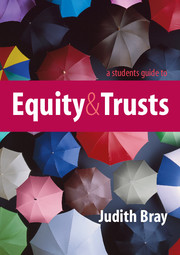Book contents
- Frontmatter
- Contents
- Preface
- 1 Historical introduction
- 2 Equitable remedies
- 3 The classification of trusts and powers
- 4 The three certainties
- 5 Constitution of trusts
- 6 Formalities for the creation of a trust
- 7 Private purpose trusts
- 8 Unincorporated associations
- 9 Resulting trusts
- 10 Constructive trusts
- 11 Trusts of the family home
- 12 Secret trusts and mutual wills
- 13 Charities; the Charities Act and the rules of cy près
- 14 Trustees: appointment, retirement and capacity
- 15 Duties and powers of trustees
- 16 Variation of trusts
- 17 Fiduciary duties and breach of fiduciary duties
- 18 Breach of trust and defences to breach of trust
- 19 Remedies against strangers to a trust
- 20 Tracing
- Index
6 - Formalities for the creation of a trust
- Frontmatter
- Contents
- Preface
- 1 Historical introduction
- 2 Equitable remedies
- 3 The classification of trusts and powers
- 4 The three certainties
- 5 Constitution of trusts
- 6 Formalities for the creation of a trust
- 7 Private purpose trusts
- 8 Unincorporated associations
- 9 Resulting trusts
- 10 Constructive trusts
- 11 Trusts of the family home
- 12 Secret trusts and mutual wills
- 13 Charities; the Charities Act and the rules of cy près
- 14 Trustees: appointment, retirement and capacity
- 15 Duties and powers of trustees
- 16 Variation of trusts
- 17 Fiduciary duties and breach of fiduciary duties
- 18 Breach of trust and defences to breach of trust
- 19 Remedies against strangers to a trust
- 20 Tracing
- Index
Summary
Key points
a trust can be created by either declaration of self as trustee or appointment of a third party as trustee;
the settlor must have the capacity to create a trust;
a trust must comply with the proper formalities on creation;
property must be validly transferred to the trustee;
the creation of a trust of land requires specific formalities;
the transfer of an interest under a trust must comply with the proper formalities; and
the formalities for the transfer of an interest under a trust can be avoided if the transfer is not a disposition of an interest under a trust.
Introduction
A key feature of the trust is that it separates the legal and beneficial interest in the property so the trustee holds the legal title and the beneficiaries hold the equitable interest. This contrasts with sole ownership of property. Once a trust has been validly created and is fully constituted it can be enforced by the beneficiaries in court. The court will step in and enforce on behalf of the beneficiaries but it will only do so once all doubt has been removed that the trust is valid. The court must first consider whether any formalities were necessary in the creation for the trust and whether they have been adhered to. Unless such formalities are complied with the court will be unable to enforce the trust.
Information
- Type
- Chapter
- Information
- A Student's Guide to Equity and Trusts , pp. 82 - 97Publisher: Cambridge University PressPrint publication year: 2012
